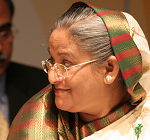Morshed Khan, Bangladesh’s foreign minister from 2001 to 2006, was fond of stating that if Bangladesh was India- locked, then Tripura was Bangladesh- locked.
Tripura and Bangladesh have a special history- the two share a porous border, which stretches over 800 kilometers. During Bangladesh’s struggle for independence, the people of Tripura welcomed more Bangladeshi refugees per capita into their homes than in any other civil war situation in history.
Prime Minister Sheikh Hasina’s current visit to Tripura is significant. Since its inception in 1971, no Bangladeshi head of state or government has visited India’s Northeast. This visit has the potential to rebalance the still tremulous relations between India and Bangladesh.
Historically, Bangladesh’s attention has been focused primarily on West Bengal (once the eastern part of undivided Bengal), with which it shares a love-hate relationship. By now turning its gaze toward the north- east, Bangladesh could be heralding a strategic change in the dynamic of its relationship with India. If such a paradigm shift commences, then West Bengal’s Chief Minister Mamta Banerjee’s tantrum, last September, over the Teesta Waters Accord, could become a blessing in disguise.
Bilateral relations between the two countries have been fractious since the 1974 assassination of Sheikh Mujibur Rahman, the father of current Prime Minister Hasina. Differences over illegal immigration into India, support for terrorist activities, especially in Assam, cattle- smuggling, and Bangladesh’s reluctance to grant India access to its transit facilities, made the exchanges infructuous. This has begun to change.
Prime Minister Hasina’s visit was preceded by the establishment of tentative links including bus services between Dhaka and Agartala, the proposed revival of the rail link from Akhaura to Agartala, and the announcement to allow our North Eastern States the use of the Chittagong Port. This could be the ballast which can cause the two countries to build a genuine and mutually constructive future. For the first time, Bangladesh even allowed heavy power equipment for the Palitana project in Tripura, to be transported along its fragile road system, in exchange for which it is seeking a stake in the project. Such exchanges are tentative, but can usher in a process of normalcy for the movement of goods between the two countries.
India and Bangladesh have already been somewhat successful in addressing complex issues related to terrorism- they have completed the demarcation of the border, which is helping to curb the infiltration of militant groups principally into Assam. What also needs to be addressed is the management of the waters and the maintenance of the banks of the Feni river, easier perhaps than addressing the sharing of the waters of the Teesta river.
Fifteen years ago, the Chambers of Commerce of Agartala and Chittagong met to discuss economic exchanges between south- eastern Bangladesh and Tripura. But little came of it. For decades, the porous border between the two has facilitated the entry of smugglers and terrorists into India. Now is the time for our countries to recognize the tremendous value and potential from increasing legal cross- border trade. Exchanging domestically produced goods: household gadgets, saris and readymade garments, pharmaceuticals, agricultural products, small machinery etc. can provide India with an opportunity to crush the smuggled- goods market in Agartala, one that is also being replenished by Chinese products brought in illegally from Bangladesh.
This is also the moment for the national and provincial governments of both countries to think ambitiously about gas swaps. Until recently, gas from Tripura could not be exploited due to geographical constraints. However, this gas can now be linked to the pipelines of the Bibiyana gas field in Eastern Bangladesh for consumption within the country, or swapped for power for West Bengal or Assam.
The future of natural gas as a source of energy for the South Asian region is vital- and could be promising. If India and Bangladesh can effectively advance their strategic partnership, a link to Myanmar’s Shwe gas field becomes a realistic goal. However, if Delhi and Dhaka cannot strengthen their diplomatic ties and cooperate to develop their energy, infrastructure and financial sectors, then futuristic projects such as TAPI (The Turkmenistan- Afghanistan- Pakistan- India pipeline project) or IPI (The Iran- Pakistan- India pipeline), become ever more ephemeral.
Tripura, rather than Bengal or Assam, is an inspired Indian partner for Bangladesh. Like most people in Tripura, Manik Sarkar, the chief minister, is a Bangla speaker, and there is a key cultural affinity that will surely make social and intellectual exchanges with Bangladesh more meaningful. Sheikh Hasina’s visit began with the inauguration of an open- air theater and a statue of Rabindranath Tagore at Tripura University, followed by the conferment of an honorary degree.
Both countries now have a mutual and abiding interest in ensuring that Tripura leads the India-Bangladesh relationship. For too long, Bangladesh has looked westwards to Assam and West Bengal to engage with India; it must now pivot and look east to Tripura and Mizoram. While the former are stalwart but still troublesome prospects, far in the distance, a more realizable and immediate strategic partner is the state of Tripura. For Bangladesh too, Tripura can be the gateway to Myanmar and ASEAN, through Mizoram. The troubles of Manipur – which is the only existing link between India and Myanmar – can thus be transcended, making Morshed Khan’s gentle but ominous threat wrong, twice over.
Neelam Deo is India’s former ambassador to Denmark and Ivory Coast, and served in Washington and New York. She is the director and co-founder of Gateway House: Indian Council on Global Relations.
This article was exclusively written for Gateway House: Indian Council on Global Relations. You can read more exclusive content here.
For interview requests with the author, or for permission to republish, please contact outreach@gatewayhouse.in.
© Copyright 2012 Gateway House: Indian Council on Global Relations. All rights reserved. Any unauthorized copying or reproduction is strictly prohibited.


